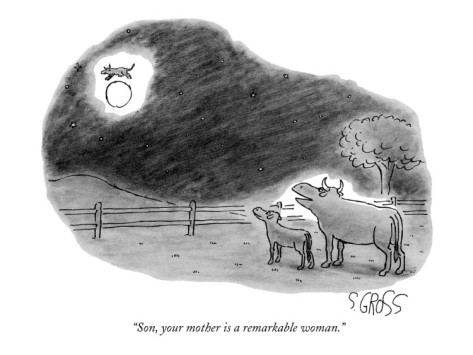At the other end of the spectrum, well, if you’ve ever seen his downright subversive 1977 collection, I Am Blind and My Dog Is Dead, or ran across his work in the National Lampoon, you know that Gross has an edge that can cut deeply.
Sam Gross: Sometimes I have to give a drawing a lot of thought afterward. I may look at it for two weeks if I’m trying to sell it to The New Yorker – or three weeks if it’s really bothering me.
There’s no time element involved with most of my work. It can go on forever, and I have drawings that are still pumping money.
“Son, your mother’s a remarkable woman,” that drawing with the cow jumping over the moon was done in 1982 and it’s going on and on. And the frogs’ legs cartoon was in the December 1970 issue of the Lampoon.
Did you know the frogs’ legs cartoon would work as well as it did while you were working on it?
I had no idea what I was doing. Not only did I not know what I was doing, I didn’t spend any time trying to figure out what I was doing. Because you can’t.
Occasionally, though, you get an idea and it glows. This happened with a fairly recent gag.
There’s a kitchen in a French restaurant and the cooks all have mustaches and toques. One of them is reaching into a bin full of frogs and there’s a big pot boiling in the back. One frog says to another, “We’ll always have Paris.”
I bring it in and Bob Mankoff holds it, then sends it back. I have it right here on my board for two weeks. What the hell am I gonna do with this? Gourmet isn’t buying cartoons anymore, and the Lampoon is gone.
Finally I brought it back to Bob and said, “I’m gonna give you and Remnick another chance on this thing.” I got to hand it to him, he took it and now it’s pumping money, but nothing like some of the others.
It glowed and punched a button. When you’re selling reprints or the original, you’re not really selling the art. You’re selling the button or whatever it is that you pressed. So I pressed a button with the frogs’ legs cartoon although I really have no idea what that button is. I do know one thing, though: Nobody draws a better frog than me. [Laughter]
Your second-most-infamous cartoon might be the one about the blind black guy. Where did that come from?
...
I was heading up to the Lampoon one day and there was a black guy holding a sign on that said “Blind since birth.” I stopped to look at him for a couple of minutes and thought, “He’s blind from birth. Does he have any concept that he’s black?”
Like every artist I have an obsession about my eyes. So I mulled this over for a day or two and came up with this gag about a guy on the street with a sign that said “Blind, and I think I may be black.”
When I came into the next Lampoon editorial meeting I got my only standing ovation for it.
Were there any reverberations from We Have Ways of Making You Laugh?
It made a bit of a ripple and then it went away. You go on to the next one. I only sold one of them to The New Yorker, but they gave it back to me after they bought it.
It made a bit of a ripple and then it went away. You go on to the next one. I only sold one of them to The New Yorker, but they gave it back to me after they bought it.
It was this clown in big shoes wearing a swastika armband. One kid says to the other kid, “There’s another reason for me to hate clowns.”
...
Did you have a philosophy of cartooning?...
The highest form of cartooning has no caption.










No comments:
Post a Comment